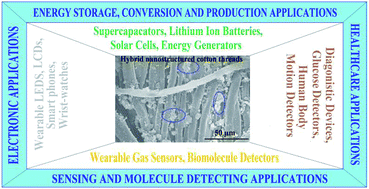Performance of hybrid nanostructured conductive cotton materials as wearable devices: an overview of materials, fabrication, properties and applications
Abstract
Smart wearable devices can be fabricated using flexible and linear cable-type materials for applications in energy, electronics, sensing and healthcare products. Such wearable devices have been prepared by incorporating conductive nanostructures, metallic nanomaterials, hybrid nanocomposites and polymer nanocomposites on the surface of flexible and permeable cotton materials (threads, fibers, yarns and fabrics). In this paper, we present an overview of preparation methods of various conductive nanomaterials, hybrids and polymer nanocomposites and their embedment on cotton based flexible materials. The embedment of these functional hybrid nanostructures on the porous and permeable materials has provided the necessary potential for the development of wearable smart devices with improved characteristic properties. Moreover, the diversity of these characteristic properties and potential applications of functionalized cotton materials has been also discussed. This review paper will boost encouragement for the development of next generation smart and flexible devices which could be worn by human beings.


 Please wait while we load your content...
Please wait while we load your content...